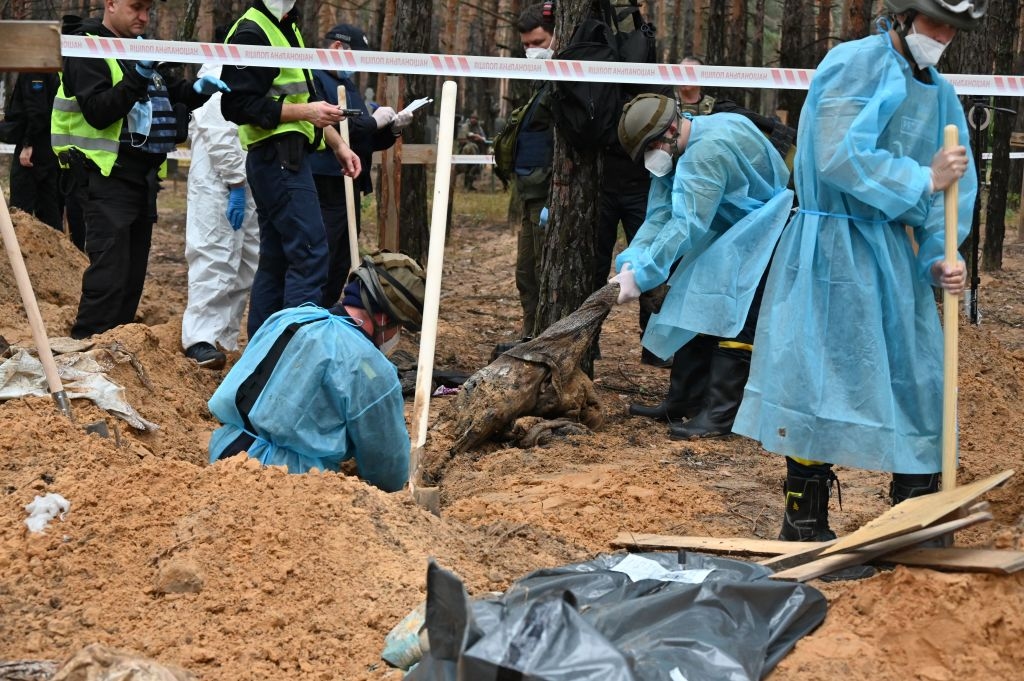Ukraine war latest: Staged secession voting begins in 4 occupied regions

Key developments on Sept. 23
- Staged voting begins in occupied Donetsk, Luhansk, Kherson and Zaporizhzhia oblasts as the Kremlin seeks to claim the invaded areas as parts of Russia
- Police find 18 torture chambers in liberated Kharkiv Oblast.
- 436 bodies exhumed at Izium’s mass burial site; 30 with traces of torture
- Russia launches 4 missile strikes, 17 airstrikes across Ukraine
Russia’s sham “referendums” started in the occupied parts of eastern and southern Ukraine on Sept. 23.
During the illegal voting, largely believed to be staged, Russian forces and proxies are allegedly asking Ukrainians whether they want their region to become a part of Russia.
The vote, condemned internationally, is scheduled to take place on Sept. 23-27 in the occupied territories of Donetsk, Luhansk, Kherson, and Zaporizhzhia oblasts.
Russia made it clear that it would use the “referendums” as a pretext for the annexation of the regions, like it did with Crimea in 2014.
The Kremlin’s spokesperson Dmitry Peskov said the Russian Constitution will immediately be in effect in the captured Ukrainian lands after the “referendum” and Moscow would treat any further Ukrainian advances on the occupied territories as an attack on Russia.
Ukraine has denounced Russia’s annexation plans. Advisor to the President's Office Mykhailo Podolyak called pseudo-referendums Russia’s “propaganda show” to aid its conscription efforts.
Staged referendums
The “voting” began at 8 a.m. in the occupied territories, Russia’s proxies reported.
In Luhansk Oblast alone, there will be more than 460 polling stations, they said. Moreover, hundreds of polling stations for the “referendum” allegedly opened in Russia, for the residents of the occupied territories living abroad.
However, the voting will take place at the polling stations only on the last day of the “referendum,” Sept. 27.
On Sept. 23-26, due to what they claimed were “security measures,” Russians and their proxies said residents will be voting in “public spaces or other places” outside of the designated polling stations.
Russia’s previous attempts to throw sham “referendums” in eastern Ukraine in 2014 showed indications that the announced results had been prepared in advance.
Meanwhile, Ukrainian officials are concerned about the safety of local residents. They have issued warnings to the residents in the occupied territories to be cautious as the occupying forces might pressure them to participate in the vote.
Luhansk Oblast Serhiy Haidai said Russian troops carrying weapons are doing a "door-to-door search" in the occupied region and forcing locals to vote.
Late on Sept. 22, Kherson city councilman Serhiy Khlan also warned local residents across the occupied southern region to be cautious and spend less time at home, because Russians would be making house calls to make people vote. The weekend would be particularly dangerous, according to him.
Khlan said Russia seeks to use the “referendum” to pick out pro-Ukrainian people in the occupied territories and crack down on them.
The official urged local residents to prioritize their safety. He said that Russians already have a list of “suspicious” people, especially those who haven’t applied for Russian citizenship yet.
Also on Sept. 22, the General Staff reported that Russia’s proxies in occupied Kherson are obtaining “personal data from local residents” based on who hasn’t been receiving Moscow’s humanitarian aid. In the occupied Starobilsk, a city in Luhansk Oblast, the report says residents were banned from leaving the city during the days of the “referendum.”

Battlefield development
On the battlefield, Ukraine continued its counteroffensive in the country’s east and south.
In eastern Donetsk Oblast, Ukraine liberated the village of Yatskivska, located some 20 kilometers east of Izium. Deputy Chief of Ukraine's General Staff Oleksii Hromov also reported that Ukraine had regained previously lost positions in the direction of Bakhmut.
In southern Kherson Oblast, the Southern Operational Command reported that Russian forces are focusing on defending their positions but also seeking to take back territories they lost amid Ukraine’s counteroffensive.
The situation on the front line is “quite difficult, tense, but under control,” according to the report.

Casualties and attacks
Russian forces launched four missile strikes and 17 airstrikes across Ukraine on Sept. 23, the General Staff reported.
Another mass grave and “torture chamber” had been found in the liberated village of Kozacha Lopan in Kharkiv Oblast, National Police Chief Ihor Klymenko said.
In total, police found 18 "torture chambers" across liberated territories of Kharkiv Oblast, according to Serhiy Pantelieiev, deputy head of the National Police’s investigation department.
Kharkiv Oblast Governor Oleh Synyehubov said the exhumation of bodies at a mass burial site in the recently liberated city of Izium is being completed on Sept. 23. A total of 436 bodies have been exhumed, with most of them containing signs of “violent death” and 30 of them “traces of torture,” he said.
The governor said there were bodies with ropes tied around their necks, tied hands, broken limbs, or gunshot wounds. Several men’s genitals were cut off, he added.
Most of the exhumed bodies belonged to civilians, while 21 were military personnel, according to Synyehubov.
In neighboring Donetsk Oblast, Governor Pavlo Kyrylenko reported that seven civilians were killed and 17 wounded in the region within a day.
In Toretsk, located halfway between Kramatorsk and occupied Donetsk, a Russian missile strike hit a residential building. Nineteen people, including two children, were rescued from the building, according to the governor. One person was injured.
Another attack on Toretsk later in the day damaged several buildings, killed two civilians and injured five.
Kyrylenko once again urged the remaining residents to evacuate from the heavily-shelled Donetsk Oblast.










